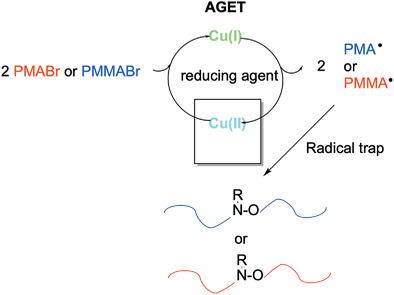当前位置:
X-MOL 学术
›
Macromol. Chem. Phys.
›
论文详情
Our official English website, www.x-mol.net, welcomes your feedback! (Note: you will need to create a separate account there.)
“Greener” Coupling of Poly(methyl methacrylate) and Poly(methyl acrylate) Chains using Activators Generated by Electron Transfer and Radical Traps
Macromolecular Chemistry and Physics ( IF 2.5 ) Pub Date : 2020-06-08 , DOI: 10.1002/macp.202000125 Katherine Xia 1 , Alia Rubaie 1 , Brendan Johnson 1 , Eric S. Tillman 1
Macromolecular Chemistry and Physics ( IF 2.5 ) Pub Date : 2020-06-08 , DOI: 10.1002/macp.202000125 Katherine Xia 1 , Alia Rubaie 1 , Brendan Johnson 1 , Eric S. Tillman 1
Affiliation

|
Monobrominated versions of poly(methyl methacrylate) (PMMABr) and poly(methyl acrylate) (PMABr) are prepared by atom transfer radical polymerization and subjected to a variety of chain end‐coupling reactions, with the goal of achieving high extents of coupling with minimal metal content. By using atom transfer radical coupling (ATRC) with radical trap assistance in conjunction with activators generated by electron transfer, high extents of coupling (Xc) could be achieved for both polymer classes without requiring copper(I) as an initial reactant, and replacing elemental copper with environmentally benign reducing agents (Xc > 0.85). Specifically, the highest extents of coupling are observed with ascorbic acid as the reducing agent along with copper(II) bromide as the pre‐catalyst. Overall, similar extents of coupling are observed while using ≈1% of the total metal of a traditional ATRC reaction for PMABr and ≈3% for PMMABr.
中文翻译:

聚(甲基丙烯酸甲酯)和聚(丙烯酸甲酯)链的“更绿色”偶联使用电子转移和自由基陷阱产生的活化剂
聚(甲基丙烯酸甲酯)(PMMABr)和聚(丙烯酸甲酯)(PMABr)的单溴化形式是通过原子转移自由基聚合制备的,并经过各种链端偶联反应,目的是实现偶联程度高,偶联反应少金属含量。通过将自由基转移辅助的原子转移自由基偶联(ATRC)与电子转移产生的活化剂结合使用,两种聚合物都可以实现较高程度的偶联(X c),而无需以铜(I)作为初始反应物,并且可以替代元素铜与环境友好的还原剂(X c> 0.85)。具体而言,在抗坏血酸作为还原剂以及溴化铜(II)作为预催化剂的情况下,偶联程度最高。总的来说,当使用传统ATRC反应的金属总量的约1%用于PMABr时,观察到相似程度的偶联,而对于PMMABr则使用约3%。
更新日期:2020-06-08
中文翻译:

聚(甲基丙烯酸甲酯)和聚(丙烯酸甲酯)链的“更绿色”偶联使用电子转移和自由基陷阱产生的活化剂
聚(甲基丙烯酸甲酯)(PMMABr)和聚(丙烯酸甲酯)(PMABr)的单溴化形式是通过原子转移自由基聚合制备的,并经过各种链端偶联反应,目的是实现偶联程度高,偶联反应少金属含量。通过将自由基转移辅助的原子转移自由基偶联(ATRC)与电子转移产生的活化剂结合使用,两种聚合物都可以实现较高程度的偶联(X c),而无需以铜(I)作为初始反应物,并且可以替代元素铜与环境友好的还原剂(X c> 0.85)。具体而言,在抗坏血酸作为还原剂以及溴化铜(II)作为预催化剂的情况下,偶联程度最高。总的来说,当使用传统ATRC反应的金属总量的约1%用于PMABr时,观察到相似程度的偶联,而对于PMMABr则使用约3%。



























 京公网安备 11010802027423号
京公网安备 11010802027423号